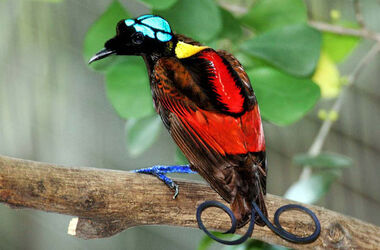
Lesser Bird-of-Paradise
These Lesser Birds of Paradise display bright plumage helping to demonstrate that they are free of disease.

Bright plumage can offer a visual cue that a male is free of disease
The Bright Male Hypothesis exerts that females can assess parasite resistance by viewing male display traits (Hamilton & Zuk, 1982; Borgia, Egeth, Uy, & Patricelli, 2004).
The hypothesis[]
The Bright Male hypothesis, as related to sexual selection, came out of a 1982 study by William Hamilton and Merlene Zuk. The paper focused on parasites and bird biological ornamentation (Hamilton & Zuk, 1982). Hamilton & Zuk (1982) proposed that sexual ornamentation allowed male birds to communicate to females that they were free of parasites and disease (Hamilton & Zuk, 1982). The hypothesis suggests that only a bird free of (or resistant to) disease could grow and support elaborate colorful plumage (Hamilton & Zuk, 1982). This visual indication of health- this brightness, would allow females to select mates who could ensure healthy, disease free, offspring (Hamilton & Zuk, 1982).
Since the hypothesis was proposed several studies have explored its validity with mixed results (Borgia et al, 2004; Folstad and Kartar, 1992; Hamilton and Poulin, 1997).
References[]
Borgia, G., Egeth, M., Uy, J., & Patricelli, G. (2004). Juvenile infection and male display: testing the bright male hypothesis across individual life histories.Behavioral Ecology, 15(5), 722-728.
Folstad, I. & Kartar, A. (1992). Parasites, bright males and the immuno-competence handicap. Am Nat 139:603–622.
Hamilton, W.J. & Poulin, R. (1997). The Hamilton and Zuk hypothesis revisited: a meta- analytical approach. Behav 134:299–320. Lond B 267:251–256.
Hamilton, W. D., & Zuk, M. (1982). Heritable true fitness and bright birds: a role for parasites?. Science, 218384-387.